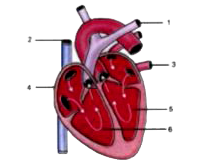__________ circulates blood to different parts of the body .
Peristaltic movement of oesophagus
Pumping of heart
Peristaltic movement of intestine
Ciliary movement of oviduct
The correct Answer is:B
To answer the question "__________ circulates blood to different parts of the body," we need to analyze the options provided and determine which one is responsible for blood circulation.
1. Identify the Options: The options given are:
- Peristaltic movement of the esophagus
- Pumping of the heart
- Peristaltic movement of the intestine
- Ciliary movement of the oviduct
2. Evaluate Each Option:
- Peristaltic movement of the esophagus: This movement is related to the digestive process, specifically the movement of food from the throat to the stomach. It does not play a role in blood circulation.
- Pumping of the heart: The heart is the central organ of the circulatory system. It pumps blood throughout the body via its chambers (two atria and two ventricles). This process is essential for circulating blood to different parts of the body.
- Peristaltic movement of the intestine: Similar to the esophagus, this movement is involved in digestion, helping to move food through the intestines. It does not circulate blood.
- Ciliary movement of the oviduct: This movement is involved in the reproductive system, specifically aiding in the transport of the egg from the ovary to the uterus. It is not related to blood circulation.
3. Conclusion: After evaluating all the options, the correct answer is the pumping of the heart, as it is responsible for circulating blood to different parts of the body.
Final Answer: Pumping of the heart
---
- Peristaltic movement of the esophagus
- Pumping of the heart
- Peristaltic movement of the intestine
- Ciliary movement of the oviduct
- Peristaltic movement of the esophagus: This movement is related to the digestive process, specifically the movement of food from the throat to the stomach. It does not play a role in blood circulation.
- Pumping of the heart: The heart is the central organ of the circulatory system. It pumps blood throughout the body via its chambers (two atria and two ventricles). This process is essential for circulating blood to different parts of the body.
- Peristaltic movement of the intestine: Similar to the esophagus, this movement is involved in digestion, helping to move food through the intestines. It does not circulate blood.
- Ciliary movement of the oviduct: This movement is involved in the reproductive system, specifically aiding in the transport of the egg from the ovary to the uterus. It is not related to blood circulation.
Topper's Solved these Questions
- LOCOMOTION AND MOVEMENTBook:AAKASH INSTITUTE ENGLISHChapter:LOCOMOTION AND MOVEMENTExercise:ASSIGNMENT SECTION-B
Explore 25 Videos
- LOCOMOTION AND MOVEMENTBook:AAKASH INSTITUTE ENGLISHChapter:LOCOMOTION AND MOVEMENTExercise:ASSIGNMENT SECTION-C
Explore 43 Videos
- LOCOMOTION AND MOVEMENTBook:AAKASH INSTITUTE ENGLISHChapter:LOCOMOTION AND MOVEMENTExercise:EXERCISE
Explore 30 Videos
- HUMAN REPRODUCTIONBook:AAKASH INSTITUTE ENGLISHChapter:HUMAN REPRODUCTIONExercise:Try Yourself
Explore 19 Videos
- MICROBES IN HUMAN WELFAREBook:AAKASH INSTITUTE ENGLISHChapter:MICROBES IN HUMAN WELFAREExercise:Assignment (SECTION - D Assertion - Reason Type Questions)
Explore 10 Videos
Similar Questions
Given alongside is a diagram of the human heart showing its internal structure. Label the parts marked 1 to 6, and answer the following questions.

Name the main artery which takes the blood from heart to different parts of the body.
View SolutionIn which of the following vertebrate group/groups,heart does not pump oxygenated blood to different parts of the body ?
View Solution
Knowledge Check
Assertion : In the human body the heart acts as the pump that circulates blood through differences parts of the body, transferring heat by force convection.
Reason : In forced convection , material is force to move by a pump or by some other physics means.AIf both assertion and reason are true and reason is the correct explanation of assertion.BIf both assertion and reason are true and reason is not the correct explanation of assertion.CIf assertion is true and reason is false.DIf both assertion and reason are false._____ is the ability to perform smooth and accurate movements involving different parts of the body
ADifferentiationBCoordinationCSubjugationDAdaptation
The oxygen-rich blood is pumped into different parts of the body through .............
View SolutionWhich of the following statement (s) is (are) true about heart?
(i) Left atrium receives oxygenated blood from different parts of body while right atrium receives deoxygenated blood from lungs
(ii) Left ventricle pumps oxygenated blood to different body parts while right ventrivle pumps deoxygenated blood to lungs
(iii) Left atrium transfers oxygenated blood to right ventricle which sends it to different body parts
(iv) Right atrium receives deoxygenated blood from different part of the body while left ventricle pumps oxygenated blood to dofferent parts of the body
View SolutionThe blood vessels which carry blood from the heart to different parts of the body are called ................
View SolutionDescribe the different constituents of the blood.
View SolutionElectrical signals sent by nerve cells to different parts of the body are called
View SolutionGive appropriate biological or technical terms for the following:
Specialized group of tissues that support and bind the different parts of the body
View Solution